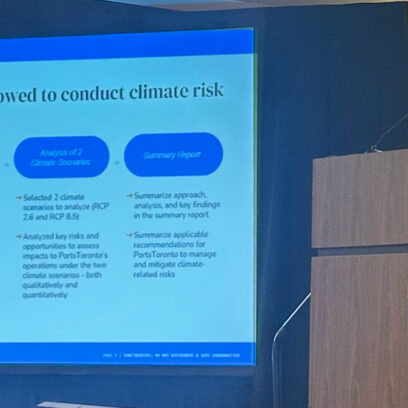The Alphabet Soup of Sustainability


🌍 Carbon markets can feel overwhelming—fragmented data, limited transparency, and conflicting advice make it hard to know where to start. In this webinar, our experts give a clear, practical introduction to the VCM.

FW Sustainability Report
Learn more about how Fierce Whiskers has made sustainable choices every step of the way by downloading its full sustainability report.

SUSTAINABILITY REPORTING OVERVIEW
Sustainability reporting serves as a valuable tool to achieve corporate commitments and better manage climate-related business risks. This white paper walks you through what’s typically included and what should be considered.
Your guide to the alphabet soup of ESG and sustainability terms—with definitions and context to help you understand each term.
From Global Reporting Initiative (GRI), to Sustainability Accounting Standards Board (SASB) through to Task Force on Climate-related Financial Disclosures (TCFD), the alphabet soup of sustainability has continued to expand and evolve in recent years. From sector benchmarks, sustainability standards and reporting frameworks to credit and corporate rating agencies, environmental, social and governance (ESG) terms often overlap. Frameworks are sometimes consolidated inaccurately, and new terms sometimes emerge to cut through the noise and streamline the messiness, though sometimes it still just feels messy and confusing. Keeping up with the changes is exhausting on a good day, let alone relaying these terms back to stakeholders.
If you’re a Chief Sustainability Officer (CSO) or ESG professional looking to report on greenhouse gas (GHG) emissions in-line with the International Sustainability Standards Board (ISSB) standards or you’re navigating the voluntary carbon market and wanting to know the difference between a Certified Emission Reduction (CER) or Verified Emission Reduction (VER), then this blog post is for you. To help untangle the acronyms and abbreviations (and also how they fit together), we have outlined some of the most common terms for sustainability reporting frameworks, regulatory bodies and more. We’re hoping to keep this list evergreen as a resource—drop me a line if you think there’s an acronym that should be added to this list!
Table of Contents
- Sustainability Reporting & Governance
- Carbon Market & Trade
- Investor Engagement & Decision-Making
- Regulatory & Legal Considerations
- Miscellaneous
- Conclusion
Sustainability Reporting & Governance
C
CDSB (Climate Disclosure Standards Board)
CDSB focuses on climate-related financial disclosure, offering a framework for companies to report climate-related information in mainstream financial filings, ensuring consistency and comparability in disclosures.
- Established by: Collaboration of business and environmental NGOs.
- Focus: Climate-related financial disclosure.
- Details: CDSB provides a framework for mainstream financial filings.
- Entities Using CDSB: Companies aiming for consistent climate-related financial disclosures.
- Choosing CDSB: Organizations looking to integrate climate-related information into financial disclosures.
CDP (Formerly Carbon Disclosure Project)
Established as a tool for measuring and disclosing environmental impacts, CDP focuses on climate change-related information. Designed for various entities from companies to regions, it promotes transparency and assigns scores for benchmarking.
- Established by: Independent organization.
- Focus: Disclosing climate change-related information.
- Details: CDP is a tool for measuring and disclosing environmental impacts, including but not limited to, climate, water and plastic.
- Entities Using CDP: Companies, cities, states, and regions.
- Choosing CDP: Entities aiming for transparency in their environmental impacts and benchmarking against peers.
E
ESRS (Environmental, Social, and Governance Reporting Standard)
ESRS offers a comprehensive reporting standard that encompasses environmental, social, and governance aspects, encouraging organizations to holistically disclose their sustainability performance.
- Established by: Various industry bodies and stakeholders.
- Focus: Comprehensive ESG reporting.
- Details: ESRS promotes holistic sustainability performance disclosure.
- Entities Using ESRS: Organizations aiming for comprehensive ESG reporting.
- Choosing ESRS: Entities looking for a broad ESG reporting framework.
G
GHG Protocol (Greenhouse Gas Protocol)
The GHG Protocol is a widely-used framework for measuring and managing greenhouse gas emissions, assisting companies in understanding and reporting their carbon footprint, ensuring transparency and consistency.
- Established by: World Resources Institute (WRI) and the World Business Council for Sustainable Development (WBCSD).
- Focus: Greenhouse gas emissions measurement and management.
- Details: GHG Protocol provides tools for carbon footprint reporting.
- Entities Using GHG Protocol: Companies and organizations globally.
- Choosing GHG Protocol: Entities aiming for consistent and transparent carbon footprint reporting.
GRI (Global Reporting Initiative)
GRI, established by the United Nations Environment Programme (UNEP) and Ceres, provides a comprehensive framework for sustainability reporting. It promotes transparency, accountability, and stakeholder engagement, covering economic, environmental, and social impacts.
- Established by: Collaboration between UNEP and Ceres.
- Focus: Comprehensive sustainability reporting.
- Details: GRI provides a comprehensive framework for sustainability reporting.
- Entities Using GRI: Major corporations like Ford and Nestlé.
- Choosing GRI: Organizations aiming for comprehensive sustainability reporting.
I
IFRS (International Financial Reporting Standards)
Primarily focused on financial reporting, IFRS is integrating sustainability reporting to ensure financial statements include relevant ESG information, bridging the gap between financial and sustainability data.
- Established by: International Accounting Standards Board (IASB).
- Focus: Financial reporting with increasing integration of ESG.
- Details: IFRS ensures financial statements include relevant ESG information.
- Entities Using IFRS: Global companies for financial reporting.
- Choosing IFRS: Organizations aiming to integrate financial and sustainability data.
IPPC (International Plant Protection Convention)
The IPPC is a multilateral treaty overseen by the Food and Agriculture Organization (FAO) of the UN. Its primary aim is to prevent the spread and introduction of pests of plants and plant products and to promote appropriate measures for their control.
- Established by: Food and Agriculture Organization (FAO) of the UN.
- Focus: Prevention and control of plant pests to protect plant resources and ensure food security.
- Details: The IPPC sets international standards for phytosanitary measures, facilitating trade and ensuring the protection of plant resources.
- Entities Using IPPC: Member countries and those involved in international trade of plants and plant products.
- Choosing IPPC: Countries and businesses aiming to align with international phytosanitary standards and ensure the protection of plant resources.
IR (Integrated Reporting)
Integrated Reporting offers a holistic view of an organization’s strategy, governance, performance, and prospects by integrating financial and non-financial information, promoting a comprehensive understanding of value creation.
- Established by: International Integrated Reporting Council (IIRC).
- Focus: Integrating financial and non-financial information.
- Details: IR provides a holistic view of an organization’s strategy and performance.
- Entities Using IR: Organizations aiming for comprehensive reporting.
- Choosing IR: Organizations aiming to integrate financial and non-financial data for a holistic view.
ISSB (International Sustainability Standards Board)
Established by the IFRS Foundation in 2021, ISSB aims to create globally consistent sustainability reporting standards. In 2023, it released its first set of TCFD-aligned standards and took over TCFD responsibilities, marking a significant step in unifying global standards.
- Established by: IFRS Foundation.
- Focus: Globally consistent sustainability reporting standards.
- Details: ISSB released its first set of TCFD-aligned standards in 2023.
- Entities Using ISSB: Organizations transitioning to globally consistent standards.
- Choosing ISSB: Organizations aiming for a unified global standard.
S
SASB (Sustainability Accounting Standards Board)
Founded in 2011, SASB provides industry-specific sustainability accounting standards, helping companies disclose material ESG information in financial filings, ensuring relevance and comparability across industries.
- Established by: Independent organization.
- Focus: Industry-specific sustainability accounting.
- Details: SASB offers industry-specific guidelines for sustainability reporting.
- Entities Using SASB: Companies like Alphabet and General Motors.
- Choosing SASB: Organizations in unique industries aiming for tailored sustainability metrics.
Scope 1 Emissions (Direct Emissions)
Direct emissions are the most immediate and tangible representation of a company’s carbon footprint. Scope 1 emissions include the GHG released directly from sources that a company owns or controls. This is the carbon footprint that is most directly under a company’s control, and it offers a clear starting point for sustainability initiatives.
- Established by: Widely recognized in GHG accounting and reporting.
- Focus: Direct emissions from owned or controlled sources.
- Details: Scope 1 covers direct emissions from activities such as company vehicles and facilities. It represents emissions that are directly produced by a company’s operations.
- Entities Affected by Scope 1 Emissions: Any business or organization with direct emissions, including manufacturing plants, transportation fleets, and office buildings.
- Reducing Scope 1 Emissions: Companies aiming to measure and reduce their direct carbon footprint should prioritize Scope 1 emissions in their sustainability reporting.
Scope 2 Emissions (Indirect Emissions from Energy Purchased)
While a company might not produce all the energy it uses, it’s responsible for the emissions from the energy it purchases. Scope 2 emissions account for the GHGs that are released during the production of the energy consumed by a company. Addressing these emissions often involves choices about energy sourcing, efficiency, and management.
- Established by: Widely recognized in GHG accounting and reporting.
- Focus: Indirect emissions from the generation of purchased energy.
- Details: Scope 2 accounts for emissions from purchased electricity, steam, heating, and cooling consumed by the company. It reflects the emissions produced in the generation of energy that the company buys.
- Entities Affected by Scope 2 emissions: Any business or organization that purchases energy for its operations.
- Reducing Scope 2 emissions: Companies looking to understand and reduce the carbon footprint of their energy consumption should consider Scope 2 emissions in their sustainability assessments.
Scope 3 Emissions (Other Indirect Emissions)
Scope 3 emissions account for any remaining emissions associated with a company within its entire value chain. From the production of materials used in products to the way consumers use and dispose of products, Scope 3 offers a comprehensive look at a company’s indirect environmental influence.
- Established by: Widely recognized in GHG accounting and reporting.
- Focus: Indirect emissions not covered in Scope 2, occurring in the company’s value chain.
- Details: Scope 3 encompasses all other indirect emissions that occur throughout a company’s value chain, including both upstream and downstream activities. This can include emissions from suppliers, product use, and end-of-life disposal.
- Entities Affected by Scope 3 emissions: Businesses aiming for a comprehensive view of their carbon footprint, especially those with extensive supply chains or significant post-consumer impacts.
- Reducing Scope 3 emissions: Companies seeking a holistic understanding of their environmental impact, beyond just their direct operations and energy consumption, should focus on reducing Scope 3 emissions.
SRG (Sustainability Reporting Guidelines)
Developed by the International Federation of Accountants (IFAC), SRG offers a comprehensive framework for organizations to report on sustainability performance, ensuring consistency and comparability in reporting practices.
- Established by: IFAC.
- Focus: Comprehensive sustainability reporting.
- Details: SRG provides a framework for sustainability performance reporting.
- Entities Using SRG: Organizations aiming for consistent sustainability reporting.
- Choosing SRG: Organizations aiming for a comprehensive framework for sustainability reporting.
T
TCFD (Task Force on Climate-related Financial Disclosures)
Established by the Financial Stability Board, TCFD provides recommendations for disclosing climate-related financial risks. It focuses on potential financial impacts of climate change, ensuring transparency and comparability in disclosures.
- Established by: Financial Stability Board.
- Focus: Climate-related financial risks and opportunities.
- Details: TCFD provides recommendations for climate-related financial disclosures.
- Entities Using TCFD: Financial institutions like BlackRock and JP Morgan Chase.
- Choosing TCFD: Organizations aiming to disclose climate-related financial risks.
TNFD (Task Force on Nature-related Financial Disclosures)
Similar to TCFD, TNFD aims to develop a framework for organizations to assess and disclose financial risks related to nature and biodiversity, ensuring transparency and risk management.
- Established by: Financial and environmental stakeholders.
- Focus: Nature-related financial disclosures.
- Details: TNFD provides a framework for nature-related financial risk assessment.
- Entities Using TNFD: Organizations aiming to disclose nature-related financial risks.
- Choosing TNFD: Entities seeking insights into financial risks related to nature and biodiversity.
U
UN SDGs (United Nations Sustainable Development Goals)
The UN SDGs, a set of 17 global goals, address various challenges, providing a roadmap for sustainable development by 2030. They offer a comprehensive framework for organizations to align their strategies and actions with global priorities.
- Established by: United Nations.
- Focus: Global sustainable development goals.
- Details: The UN SDGs provide a roadmap for sustainable development by 2030.
- Entities Using UN SDGs: Governments, NGOs, and businesses.
- Choosing UN SDGs: Organizations aiming to align with global sustainable development priorities.
UNGC (United Nations Global Compact)
The UNGC is a voluntary initiative for businesses to align their operations and strategies with ten universally accepted principles in areas like human rights and environment, promoting responsible business practices.
- Established by: United Nations.
- Focus: Aligning business operations with universally accepted principles.
- Details: UNGC promotes responsible business practices.
- Entities Using UNGC: Businesses globally.
- Choosing UNGC: Companies aiming to align with global principles on human rights, labor, environment, and anti-corruption.
Carbon Market & Trade
A
ACR (American Carbon Registry)
ACR, a private nonprofit, provides standards and oversight for voluntary carbon offset projects in the U.S., ensuring credibility and effectiveness in carbon offset initiatives.
- Established by: Winrock International.
- Focus: Voluntary carbon offset projects.
- Details: ACR provides standards and oversight for carbon offset projects.
- Entities Using ACR: U.S. companies and organizations aiming for carbon neutrality.
- Choosing ACR: Entities seeking credible carbon offset projects in the U.S.
C
CAR (Climate Action Reserve)
The Climate Action Reserve is a carbon offset registry for the North American carbon market. It establishes high-quality standards for carbon offset projects, ensuring transparency, credibility, and environmental integrity.
- Established by: Non-profit organization.
- Focus: Carbon offset projects and protocols.
- Details: CAR ensures the creation of high-quality carbon offset credits.
- Entities Using CAR: Companies and organizations in North America.
- Choosing CAR: Entities aiming for credible carbon offset projects in North America.
CBCO (Carbonbetter Certified Offsets)
CarbonBetter offers a unique approach to carbon offsetting, providing hand-picked carbon offset portfolios that blend a variety of projects, geographies, and technologies. Our CBCO Portfolios are designed to simplify the process for organizations, eliminating the need for lengthy request for proposal (RFP) processes and ensuring access to high-quality carbon credits. CBCO Portfolios offer transparency and traceability and come with ready-to-use marketing collateral, providing an easy solution for organizations wanting to offset their emissions immediately.
- Established by: CarbonBetter.
- Focus: Hand-selected carbon offset portfolios with a blend of curated projects.
- Details: CBCO Portfolios provide a mix of high-quality projects vetted for proven additionality and impactful co-benefits.
- Entities Using CBCO: Organizations aiming for credible carbon offset projects.
- Choosing CBCO: Entities seeking a simplified and trustworthy approach to carbon offsetting.
CBAM (Carbon Border Adjustment Mechanism)
As part of the European Green Deal, the European Union (EU) introduced the CBAM to prevent carbon leakage. This mechanism ensures that the price of imports reflects their carbon content, leveling the playing field for products from countries with less stringent emission regulations. By adjusting the carbon cost at the border, the CBAM aims to encourage industries worldwide to reduce their carbon emissions, aligning with the EU’s ambitious climate goals.
- Established by: EU.
- Focus: Preventing carbon leakage by adjusting the carbon cost of imports.
- Details: CBAM ensures that the price of imports into the EU reflects their carbon content, promoting global emission reductions.
- Entities Using CBAM: Industries importing goods into the EU.
- Choosing CBAM: Industries aiming to align with the EU’s climate goals and regulations.
CER (Certified Emission Reduction)
CERs are carbon credits generated under the Clean Development Mechanism (CDM) of the Kyoto Protocol, representing verified emission reductions or removals achieved by CDM projects.
- Established by: Kyoto Protocol’s Clean Development Mechanism (CDM).
- Focus: Emission reductions or removals.
- Details: CERs represent verified emission reductions from CDM projects.
- Entities Using CER: Countries and organizations participating in the Kyoto Protocol.
- Choosing CER: Entities aiming to meet Kyoto Protocol commitments through verified emission reductions.
CFT (Carbon Financial Tool)
CFT is an instrument used in some carbon markets to manage carbon price risk, facilitate trading, and provide price discovery, ensuring effective carbon market operations.
- Established by: Various carbon markets.
- Focus: Managing carbon price risk and facilitating trading.
- Details: CFT is used for price discovery in carbon markets.
- Entities Using CFT: Participants in carbon markets.
- Choosing CFT: Entities active in carbon markets aiming to manage price risk.
E
EU ETS (European Union Emission Trading System)
The EU ETS, a marketplace for carbon allowances, is a cornerstone of the EU’s policy to combat climate change, aiming to reduce GHG emissions in a cost-effective manner.
- Established by: EU.
- Focus: Cap-and-trade system for GHG emissions.
- Details: EU ETS is a major tool for reducing GHG emissions in the EU.
- Entities Using EU ETS: Industries and airlines operating in the EU.
- Choosing EU ETS: Entities under the EU’s jurisdiction aiming to reduce emissions in line with EU targets.
G
GS (Gold Standard)
Gold Standard, a certification for carbon projects, ensures not only emissions reduction but also contributions to sustainable development, amplifying the positive impact of carbon offset initiatives.
- Established by: WWF and other international NGOs.
- Focus: Carbon projects contributing to sustainable development.
- Details: GS ensures broader positive impacts of carbon offset projects.
- Entities Using GS: Organizations aiming for high-quality carbon offset projects.
- Choosing GS: Entities seeking carbon projects with broader sustainable development benefits.
R
RGGI (Regional Greenhouse Gas Initiative)
RGGI is a mandatory cap-and-trade system in the northeastern U.S., aiming to reduce carbon dioxide emissions from power plants, ensuring regional collaboration in combating climate change.
- Established by: Northeastern U.S. states.
- Focus: Reducing carbon dioxide emissions from power plants.
- Details: RGGI is a regional initiative for reducing emissions from power plants.
- Entities Using RGGI: Power plants in participating states.
- Choosing RGGI: Power plants in the northeastern U.S. aiming to meet regional emission reduction targets.
V
VCM (Voluntary Carbon Market)
The Voluntary Carbon Market allows entities to offset their emissions by purchasing carbon credits from projects that reduce or remove GHG emissions. It provides flexibility for organizations to meet their sustainability goals.
- Established by: Various standards and initiatives.
- Focus: Voluntary carbon offsetting.
- Details: VCM facilitates the trading of carbon credits outside of regulatory systems.
- Entities Using VCM: Companies, governments, and individuals.
- Choosing VCM: Entities aiming to voluntarily offset their carbon emissions.
VCS (Verra Carbon Standard)
Verra Carbon Standard is a leading standard for voluntary GHG reduction and removal projects globally. It ensures that carbon credits are real, measurable, and additional, providing confidence in carbon offset initiatives.
- Established by: Verra.
- Focus: GHG reduction and removal projects.
- Details: VCS provides a robust framework for carbon offset projects.
- Entities Using VCS: Organizations worldwide.
- Choosing VCS: Entities seeking high-quality carbon offset projects on a global scale.
VER (Verified Emission Reduction)
VERs are carbon credits representing verified GHG emission reductions, certified by recognized standards or programs, ensuring credibility in carbon offset initiatives.
- Established by: Various recognized standards or programs.
- Focus: Verified GHG emission reductions.
- Details: VERs represent verified emission reductions.
- Entities Using VER: Organizations aiming for credible carbon offset projects.
- Choosing VER: Entities seeking verified emission reductions from recognized standards.
VBCs (VOLUNTARY BIODIVERSITY CREDITS)
VBCs are an emerging tool designed to financially support nature restoration and nature-positive initiatives, assigning an economic value to efforts that preserve or restore ecosystems without offsetting damage elsewhere.
- Established by: Global Biodiversity Framework (GBF) and various conservation organizations.
- Focus: Biodiversity conservation and nature restoration.
- Details: VBCs are a nascent mechanism to fund nature-positive agendas, representing a specific amount of space actively conserved for a set duration.
- Entities Using VBCs: Companies like LendLease, Porsche Australia, and the University of Melbourne.
- Choosing VBCs: Businesses aiming to contribute to nature restoration and enhance their sustainability profile.
W
WCI (Western Climate Initiative)
WCI is a collaboration between several U.S. states and Canadian provinces, aiming to establish a cap-and-trade system and other policies to reduce GHG emissions, promoting regional collaboration.
- Established by: U.S. states and Canadian provinces.
- Focus: Cap-and-trade system and policies for emission reduction.
- Details: WCI promotes regional collaboration in reducing GHG emissions.
- Entities Using WCI: Industries in participating states and provinces.
- Choosing WCI: Entities in the western U.S. and Canada aiming for regional collaboration in emission reduction.
Investor Engagement & Decision-Making
D
DJSI (Dow Jones Sustainability Indices)
The DJSI assesses the sustainability performance of companies across industries, offering investors insights into companies’ ESG practices, guiding investment decisions based on sustainability metrics.
- Established by: S&P Dow Jones Indices and SAM.
- Focus: Sustainability performance assessment.
- Details: DJSI provides insights into companies’ ESG practices.
- Entities Using DJSI: Investors and companies.
- Choosing DJSI: Investors looking for insights into companies’ sustainability performance.
M
MSCI (Morgan Stanley Capital International)
MSCI offers ESG ratings and indexes, assisting investors in assessing companies’ sustainability performance and incorporating ESG factors into investment decisions, promoting responsible investment.
- Established by: Morgan Stanley Capital International.
- Focus: ESG ratings and indexes.
- Details: MSCI provides insights into companies’ sustainability performance.
- Entities Using MSCI: Investors globally.
- Choosing MSCI: Investors aiming to incorporate ESG factors into investment decisions.
P
PRI (Principles for Responsible Investment)
The PRI provides a set of principles guiding investors in incorporating ESG factors into investment decisions, promoting sustainable and responsible investment practices, and ensuring long-term value creation.
- Established by: United Nations-supported initiative.
- Focus: Responsible investment principles.
- Details: PRI promotes sustainable and responsible investment practices.
- Entities Using PRI: Institutional investors.
- Choosing PRI: Investors aiming for responsible investment practices.
Regulatory & Legal Considerations
C
CSRD (Corporate Sustainability Reporting Directive)
The CSRD, an EU directive, revises and expands the existing Non-Financial Reporting Directive (NFRD), aiming to enhance the consistency, comparability, and quality of corporate sustainability reporting across EU member states, ensuring a unified approach.
- Established by: EU.
- Focus: Corporate sustainability reporting.
- Details: CSRD aims to enhance sustainability reporting across the EU.
- Entities Using CSRD: Companies operating within the EU.
- Choosing CSRD: Companies aiming to comply with EU sustainability reporting requirements.
E
EPA (Environmental Protection Agency)
The EPA is responsible for protecting human health and the environment in the U.S. It sets and enforces regulations related to air, water, and land, ensuring compliance with environmental laws.
- Established by: U.S. federal government.
- Focus: Environmental protection and regulation.
- Details: EPA oversees environmental regulations and ensures compliance.
- Entities Using EPA: Industries, states, and local governments in the U.S.
- Choosing EPA: Entities aiming to comply with U.S. environmental regulations.
I
ISO (International Organization for Standardization)
ISO develops international standards, including various aspects of sustainability like environmental management (ISO 14001) and social responsibility (ISO 26000), ensuring global consistency and best practices.
- Established by: Independent, non-governmental international organization.
- Focus: International standards development.
- Details: ISO provides standards for various aspects of sustainability.
- Entities Using ISO: Companies and organizations globally.
- Choosing ISO: Entities aiming for global consistency in sustainability practices.
N
NFRD (Non-Financial Reporting Directive)
The NFRD, an EU directive, initially mandated large companies to disclose non-financial and diversity information, emphasizing transparency in sustainability reporting. With the introduction of the CSRD, the NFRD’s guidelines have been expanded and refined to further enhance corporate sustainability reporting standards across EU member states.
- Established by: EU.
- Focus: Mandating non-financial and diversity disclosures by large companies.
- Details: Set the foundation for corporate disclosures on social, environmental, and governance practices, now succeeded and expanded by the CSRD.
- Entities Using NFRD: Large companies operating within the EU before the introduction of CSRD.
- Choosing NFRD: Companies that were aiming to align with initial EU sustainability reporting requirements prior to the CSRD.
S
SEC (Securities and Exchange Commission)
The SEC oversees the financial markets and protects investors in the United States. Recently, it has been focusing on ensuring that companies provide meaningful and comprehensive disclosures on climate-related risks and their impact on business operations.
- Established by: U.S. federal government.
- Focus: Financial markets oversight and investor protection.
- Details: SEC emphasizes transparency in financial disclosures, including those related to climate risks.
- Entities Using SEC: Publicly traded companies in the U.S.
- Choosing SEC: Companies aiming to comply with U.S. financial disclosure regulations.
Miscellaneous
B
B Corp Certification
B Corps meet rigorous standards of social and environmental performance, accountability, and transparency, demonstrating a commitment to balancing profit and purpose, setting a gold standard for responsible business.
- Established by: B Lab.
- Focus: Social and environmental performance.
- Details: B Corps balance profit and purpose.
- Entities Using B Corp: Companies like Patagonia and Ben & Jerry’s.
- Choosing B Corp: Companies aiming for high standards of social and environmental responsibility.
BVCM (Beyond Value Chain Mitigation)
Introduced by the Science Based Targets initiative (SBTi), BVCM emphasizes the need for companies to extend their mitigation efforts beyond their immediate value chains, addressing broader environmental impacts.
- Established by: Science Based Targets initiative (SBTi).
- Focus: Broadening mitigation activities beyond the company’s direct value chain.
- Details: Encourages investments in external mitigation activities, addressing the gap highlighted by the IPCC between current emissions trajectories and 2030 targets.
- Entities Using BVCM: Companies validated by SBTi, looking to exceed their science-based targets.
- Choosing BVCM: Companies seeking a holistic approach to sustainability, aiming to make a broader environmental impact.
N
NDC (Nationally Determined Contributions)
Under the Paris Agreement, countries submit NDCs outlining their targets for reducing greenhouse gas emissions and adapting to climate change, ensuring global collaboration in combating climate change.
- Established by: Paris Agreement.
- Focus: GHG reduction targets.
- Details: NDCs provide a roadmap for countries under the Paris Agreement.
- Entities Using NDC: Countries globally.
- Choosing NDC: Countries aiming to meet Paris Agreement commitments.
W
WEF (World Economic Forum)
The WEF engages stakeholders to promote sustainable and inclusive economic development, contributing to discussions and initiatives related to sustainability and global challenges, fostering collaboration and innovation.
- Established by: Independent international organization.
- Focus: Sustainable and inclusive economic development.
- Details: WEF promotes discussions and initiatives on global challenges.
- Entities Using WEF: Governments, businesses, and civil society.
- Choosing WEF: Entities aiming for collaboration on global sustainability challenges.
Conclusion
At first glance, the alphabet soup of acronyms and regulatory bodies may feel endless, fragmented and unnecessarily complex. The recent ISSB and TCFD consolidation, compounded by the upcoming SEC Final Rule, suggest that the tides are changing, albeit slowly and with some confusion along the way.
Navigating the ambiguity and understanding which frameworks and standards fit your organizations’ reporting needs will be critical for choosing the right sustainability frameworks, reporting processes and carbon credits. For guidance on reporting in alignment with reporting frameworks or understanding which regulations you may be eligible for, we can help. Contact us today to learn more.
While both ESG and sustainability focus on responsible business practices, they have distinct differences. ESG refers to the environmental, social, and governance factors that investors consider when evaluating a company’s ethical impact and sustainable practices. Sustainability, on the other hand, is a broader concept that encompasses strategies and practices that meet current needs without compromising the ability of future generations to meet their own needs.
The frequency of updates varies. Some standards, especially those tied to dynamic sectors or emerging technologies, might be updated more frequently. It’s crucial for businesses to stay informed and regularly check for updates from standard-setting bodies or organizations.
While many of the terms and standards mentioned are voluntary, some have regulatory implications, especially in specific regions or countries. For instance, the EU has directives like the NFRD and CSRD. However, it’s essential to note that while there isn’t a single global regulatory body, international agreements, like the Paris Agreement, influence national regulations and standards.
At CarbonBetter, we specialize in the environmental pillar of the ESG framework. We offer a comprehensive suite of decarbonization services tailored to businesses’ unique needs. From carbon footprint analysis and reduction strategies to renewable energy procurement and carbon offset solutions, we provide the tools and expertise necessary for businesses to achieve their environmental goals. Additionally, our services in supply chain decarbonization and Scope 3 emissions assessment ensure that companies can address their entire emissions profile. By partnering with CarbonBetter, businesses not only strengthen the ‘E’ in their ESG approach but also position themselves as leaders in environmental sustainability. Contact us today to learn more.
The sustainability landscape is continually evolving. While the post covers many established terms, businesses should keep an eye on emerging concepts, especially those related to technological advancements in sustainability, new regulatory requirements, or global sustainability goals. Subscribe to our newsletter to stay up-to-date on all the latest sustainability news that you need to know.


